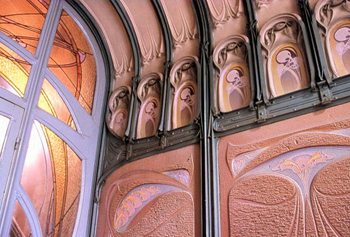Product Description
Hector Guimard for Maison Coilliot / Art Nouveau glazed lava tile 1898


HECTOR GUIMARD (1867-1942) France
MAISON COILLIOT Lille, France
Tile c. 1898
Fired and glazed lava with abstract whiplash motifs in various tones of aqua blue on the obverse and a partial graphic on the reverse with polychrome floral and linear details.
Marks: 16 (on top of tile)
French architect Hector Guimard (1867-1942) realized the decorative possibilities of glazed lava, a substance made from mixing pulverized lava with clay when he built a villa for Louis Coillot, (1898-1900) a ceramics manufacturer in Lille who monopolized the distribution of the material. Guimard sided the entire facade of Maison Coilliot in lava stone.
***A related glazed lava tile from the Castel Henriette is in the Collection of the Musee d’Orsay.
The Maison Coilliot is an Art Nouveau house located on 14, rue de Fleurus in Lille, France. Louis Coilliot, a French ceramic entrepreneur, was fond of enameled lava and wanted to popularize the technique. To do so, Coilliot commissioned Hector Guimard, an architect he’d met at the 1897 fair La Céramique et tous les arts du feu, (“Ceramic Arts & Glass Making”), to apply the technique to his house’s façade. Coilliot’s factory and warehouse were located to the rear of his house, and therefore the façade held a double
purpose, both decorating the front of his home and advertising his business.
For more information see: Hector Guimard, 1867-1942: Architektur in Paris um 1900 (Munich: Museum Villa Stuck, 1975)
H: 25 1/2″ x W: 14″ x D: 9/16″
Hector Guimard for Maison Coilliot / Art Nouveau glazed lava tile 1898
PAUL LÁSZLÓ (1900-1993) Austria / USA
MARIA ROTT (enamel) Vienna, Austria
Enameled sterling cigarette case c.1925
Hand painted foil backed and colorful fired enamel scene with a figure and a flowering plant all within a red enamel border on sterling
Marks: Paul Laszlo (on inside edge, rubbed), RS in a cartouche (Vienna maker’s mark), STERLING
H: 4″ x W: 3″ x D: 3/8″
Matching enamel dresser set by Paul Laszlo illustrated: “Kunsthandwerk” Band 62, Heft 5, February 1930
Born in Budapest, the architect Paul Laszlo studied in Vienna, Paris and Berlin before setting up an office in Vienna. By 1927, Laszlo had moved to Stuttgart where he quickly made a name for himself across Europe. In 1936, he relocated to Beverly Hills, California, which had become a haven for many artists and designers seeking artistic freedom. There he quietly found work designing modern homes and interiors, often for Hollywood celebrities. Laszlo created textiles, lamps, as well as custom furniture for his modernist homes and corporate interiors. His comfortable, yet elegant designs pay tribute to the modern luxury and easy livability of the early to mid 20th Century interiors of Vienna.
This enamel on sterling case really is one of the very best fired enamel examples of its type. It has a wonderful range of beautifully toned and colored enamel with foil backing in some areas which also gives it extra luminosity and metallic glow. It is in perfect condition and the detail and masterful artistic quality of the painting is also extremely fine and exquisitely rendered.
It has all the style and characteristics of the accomplished Neue Shachlichkeit (or New Realism / Objectivity) painting style Laszlo would have been familiar with and exposed to either in Berlin or Stuttgart as well as the New Realism style in Vogue in Vienna, where Laszlo also worked in the 1920’s. Considering the difficulty in controlling fired enamel, this exceptional Laszlo enameled case is a bargain by comparison of the price per square inch of a comparable painting on canvas such as a Christian Schad or Otto Dix! In fact, paintings are vastly more simple to execute and immediately rendered by comparison to a fired enamel “painting” on sterling like this exceptional case which would require a very lengthy and tedious process to accomplish a work of this caliber.
Paul Laszlo left Germany for America in 1936 and established a successful design firm in Beverly Hills, became an American citizen and lived happily in Southern California for the rest of his life.
